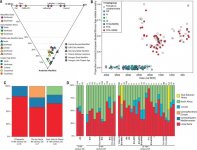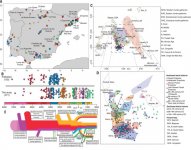Angela
Elite member
- Messages
- 21,823
- Reaction score
- 12,329
- Points
- 113
- Ethnic group
- Italian
As a side note, I'd say that the age of the sample roughly corresponding to the upper limit of CI 95% provided by YFull for formation suggests that this clade (I1-S5619) must have originated around there. More than that, a I1-S5619 obviously descend from a full developed I1 necessarily, and I1's CI 95% TMRCA is 5100-4000 ybp (we could say 5200-4000 ybp based on the range for I1-S5619 formation).
Considering the SNPs upstream S5619 till this "complete" I1 - the MRCA -, five are located in combBED region of Y chromosome - the one used by YFull for age estimation. 5 SNPs in a CI 95% generally mean a lower limit of ~400 years. I'm using this lower limit here since the actual I1's MRCA unlikely lived so out of YFull interval, then I was guessing something like 5700 ybb for the actual TMRCA of I1, more or less. Assuming that the date of Cx161 is correct.
Conclusion is that I think it's pretty possible that the I1 MRCA, from Neolithic, lived somewhere in France, or close to. While some pre-I1s were mostly Wester Hunter-Gatherers in Autosomal and something else before that, others were likely farmers mostly, like the MRCA individual, too.
In post number 30, you can see that what they label I1a2b4~ has a calibrated date which is quite a bit younger.
Last edited:



